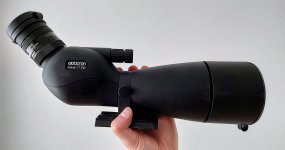AuntySocial
Member

I'm looking at getting hold of a first scope and have very little experience of the format.
I aim to look at as many as possible and make some notes/scores of their qualities and features. The problem is that I don't know what exactly I'm looking for and would like some help in coming up with a test procedure that will cover the basics, e.g. a standard image at a set distance in a similar light and how to score what I see.
I'm steering towards 60-66 and probably a zoom and fixed EP. I'm aware I will find it more difficult to try fixed so might just test zooms... Budget is mid-range for new but would prefer a good second hand scope. No hurry for a scope though, I've been with bins only for 30 years.
If anyone has a basic procedure they might share I'd be very grateful.
Thanks, Adam.
I aim to look at as many as possible and make some notes/scores of their qualities and features. The problem is that I don't know what exactly I'm looking for and would like some help in coming up with a test procedure that will cover the basics, e.g. a standard image at a set distance in a similar light and how to score what I see.
I'm steering towards 60-66 and probably a zoom and fixed EP. I'm aware I will find it more difficult to try fixed so might just test zooms... Budget is mid-range for new but would prefer a good second hand scope. No hurry for a scope though, I've been with bins only for 30 years.
If anyone has a basic procedure they might share I'd be very grateful.
Thanks, Adam.







